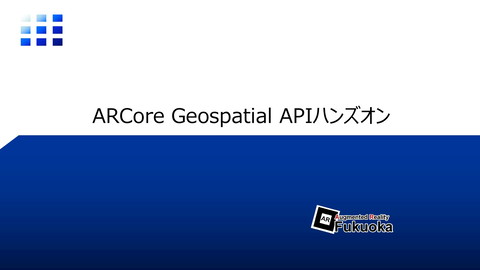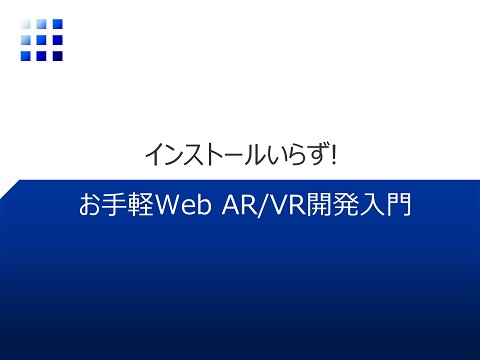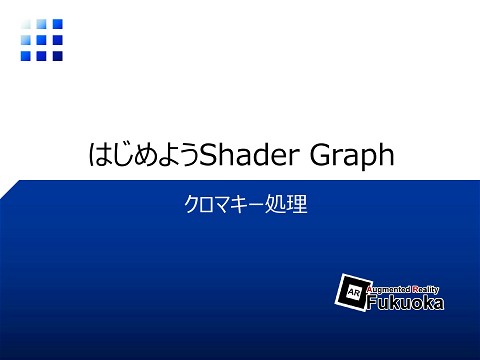Getting Started with ARCore Geospatial API & Unity
216.9K Views
June 06, 22
スライド概要
可視化技術や人間計測/空間計測技術を活用した問題解決に関する研究開発。 ARコンテンツ作成勉強会(tryAR)を主催。
関連スライド
各ページのテキスト
Getting Started with ARCore Geospatial API
Goal of This Tutorial Low Accuracy! Display Tracking Results Tracking accuracy check High Accuracy! CG display at specified latitude and longitude
Download Sample Data https://github.com/TakashiYoshinaga/ARFukuoka/raw/main/GeospatialAPI_20220604/Smples.zip
Tutorial Procedure p Creating a Unity Project p Installing AR Foundation and ARCore Extensions p Setting up a scene using the Geospatial API and ARCore/ARKit p Getting and displaying tracking information via Geospatial API p Application installation on smartphone p Display objects at specified latitude and longitude
Tutorial Procedure p Creating a Unity Project p Installing AR Foundation and ARCore Extensions p Setting up a scene using the Geospatial API and ARCore/ARKit p Getting and displaying tracking information via Geospatial API p Application installation on smartphone p Display objects at specified latitude and longitude
Launch Unity Hub Unity Hub
Project Creation (1/6) ①Projects ②New Project
Project Creation (2/6) Open Editor Version
Project Creation (3/6) 2020.3.xxf1 This document assumes 2020.3.x for explanation.
Project Creation (4/6) ①3D ②Project name ③ Storage location
Project Creation (5/6) Create project
Project Creation (6/6) When the Unity Editor appears, you are ready to go!
Build Settings for Android/iOS (1/4) File
Build Settings for Android/iOS (2/4) Build Settings
Build Settings for Android/iOS (3/4) ①Select Android or iOS ②Switch Platform
Build Settings for Android/iOS (4/4) Player Settings
Build Settings for Android For Android
Build Settings for Android (1/3) ①Other Settings ②Click Vulkan ③ Delete
Build Settings for Android (2/3) ①Identification ②Minimum API Level ③ Select Android 7.0 ʻNougatʼ API Level 24
Build Settings for Android (3/3) ①Configuration ②Scripting Backend ③Select IL2CPP ④Select ARM64
Build Settings for iOS For iOS
Build Settings for iOS ①Configuraton ② Set [Required for AR] for each Usage Description
Tutorial Procedure p Creating a Unity Project p Installing AR Foundation and ARCore Extensions p Setting up a scene using the Geospatial API and ARCore/ARKit p Getting and displaying tracking information via Geospatial API p Application installation on smartphone p Display objects at specified latitude and longitude
Prepare to download packages (1/3) Window
Prepare to download packages (2/3) Package Manager
Prepare to download packages (3/3) Select Unity Registry from Packages
Installation of AR Foundation (1/2) Search AR
Installation of AR Foundation (2/2) ①ARFoundation ② Install
Install ARCore or ARKit ①Android: ARCore XR Plugin iOS: ARKit XR Plugin ② Install
Installing ARCore Extensions (1/3) Click + [Note] ARFoundation and ARCore/ARKit are only tools to realize AR. The ARCore Extensions is necessary to use Geospatial API, which is the main topic of this article.
Installing ARCore Extensions (2/3) Add package from git URL
Installing ARCore Extensions (3/3) Search below https://github.com/google-ar/arcore-unity-extensions.git
Note If the PC you are using is not configured for GitHub connection, an error will occur.
Installation of ARCore Extensions (supplement) Access the ARCore Extensions repository https://github.com/google-ar/arcore-unity-extensions.git Click Releases
Installation of ARCore Extensions (supplement) v.1.35.0 Scroll down a little
Installation of ARCore Extensions (supplement) Assets Download arcore-unity-extensions-1.35.0.tgz
Installation of ARCore Extensions (supplement) Move arcore-unity-extensions-1.35.0.tgz to the Packages folder in the folder of the project you have just created for this tutorial.
Installation of ARCore Extensions (supplement) Add package from git tarball
Installation of ARCore Extensions (supplement) Select arcore-unity-extentions
End of supplementary information
Confirmation of installation results Select In Project from Packages
Confirmation of installation results You can find ARCore Extensions
Get a sample of GeospatialAPI ①ARCore Extensions ②Samples ③ Import Geospatial Sample
Note Might have errors in environments that do not have the iOS build option installed.
Resolving iOS-related errors (Supplemental) You may get a red text error.
Resolving iOS-related errors (Supplemental) Samples -> ARCore Extensions ->1.35.0 ->GeospatialSample ->Scripts
Resolving iOS-related errors (Supplemental) Delete Editor
Resolving iOS-related errors (Supplemental) Console If the error disappears after clicking Clear, OK.
Resolving iOS-related errors (Supplemental) Display Project tab
End of supplementary information
Installation of ARCore Extensions is complete! Close Package Manager
Next, configure the tools you have installed so far for use in this project.
ARCore or ARKit Usage Settings (1/4) ① Edit ② Project Settings
ARCore or ARKit Usage Settings (2/4) XR Plug-in Management
ARCore or ARKit Usage Settings (3/4) For Android Turn on ARCore
ARCore or ARKit Usage Settings (4/4) For iOS Turn on ARKit
ARCore Extensions Usage Settings (1/6) ARCore Extensions
ARCore Extensions Usage Settings (2/6) [For iOS] Check the iOS Support Enabled checkbox
ARCore Extensions Usage Settings (3/6) Notice the item drop-down for Android or iOS
ARCore Extensions Usage Settings (4/6) Select APIKey from the drop-down menu
ARCore Extensions Usage Settings (5/6) API Key input pre-created in Google Cloud ※ See [Set up a Google Cloud Project] of the official website for how to create an API Key.[Link]
ARCore Extensions Usage Settings (6/6) Turn on Geospatial
ARCore Extensions usage setup completed! Close Project Settings
Tutorial Procedure p Creating a Unity Project p Installing AR Foundation and ARCore Extensions p Setting up a scene using the Geospatial API and ARCore/ARKit p Getting and displaying tracking information via Geospatial API p Application installation on smartphone p Display objects at specified latitude and longitude
Creating a scene (1/4) File
Creating a scene (2/4) Save As...
Creating a scene (3/4) Sample Save
Creating a scene (4/4) Assets Sample should be added
First, set up ARFoundation to realize AR experience in this scene (*GeospatialAPI will appear a little later)
Setting up AR Foundation (1/7) Delete MainCamera
Setting up AR Foundation (2/7) Right-click on a blank space in Hierarchy with nothing selected.
Setting up AR Foundation (3/7) ①XR ②AR Session Origin
Setting up AR Foundation (4/7) AR Session Origin should appear
Setting up AR Foundation (5/7) Right-click on a blank space in Hierarchy with nothing selected.
Setting up AR Foundation (6/7) ①XR ②AR Session
Setting up AR Foundation (7/7) AR Session should appear
Prepare to use Anchor, which ties an object to be displayed in AR to a specific location. The ability to align when looking there again even if the tracking is lost. Even if the CG placed at the specified latitude and longitude is lost, it will come back!
Setting up AR Anchor Manager (1/3) ①AR SessionOrigin ②Add Component
Setting up AR Anchor Manager (2/3) ①Search AR ②AR Anchor Manager
Setting up AR Anchor Manager (3/3) ARAnchorManager should be added
Enable the results of position and direction estimation by Geospatial API to be used in this scene
Setting up AR Earth Manager (1/3) ①AR SessionOrigin ②Add Component
Setting up AR Earth Manager (2/3) ①Search AR Earth ②AR Earth Manager
Setting up AR Earth Manager (3/3) AREarthManager should be added
Using the Geospatial API also requires permission to access location information, etc. But… You don't want to write the Permission-related details, do you?
Take advantage of official scripts for easy setup!
Adding a object to set up permission (1/2) Right-click on a blank space in Hierarchy with nothing selected.
Adding a object to set up permission (2/2) ②AR Extensions ①XR
Permission-related script settings (1/9) ARCore Extensions In this area, you can pass the following script that is running in this scene and it will do the Permission-related settings. ・ARSession ・ARSessionOrigin ・ARCameraManager ・ARCoreExtensionConfiguration
Permission-related script settings (2/9) of Sessoin
Permission-related script settings (3/9) Scene AR Session [Explanation] The ARSession script is attached to the AR Session object in this scene (in the Hierarchy)
Permission-related script settings (4/9) of SessoinOrigin
Permission-related script settings (5/9) Scene AR Session Origin
Permission-related script settings (6/9) of CameraManager
Permission-related script settings (7/9) Scene AR Camera
Permission-related script settings (8/9) of ARCoreExtensionsConfig
Permission-related script settings (9/9) Scene GeospatialConfig
Permission setup completed! Allocation completed (CameraConfigFilter is not required)
現状確認 AR Earth Manager It is possible to obtain the terminal support status, the success or failure of Geospatial API initialization, and the results of position and orientation estimation. Permission setting is done by Extensions. However, it is available only when tracking by GeospatialAPI has started. Start tracking by script!
Aside: Official Sample There is a scene in the official sample to learn the steps from initialization to Geospatial API utilization.
Aside: Official Sample Samples ->ARCore Extensions ->1.35.0 ->Geospatial Sample
Aside: Official Sample Scripts GeospatialController
Aside: Official Sample The GeospatialController script contains code for initialization, position acquisition, and saving and reproducing object placement. However, both initialization and data utilization are described together, making it difficult to reuse for other purposes
I have prepared a script that isolates only the initialization code to start tracking. Aside from the details, let’s use it now!
Importing sample assets (1/3) ①Samples Folder ②Double click AR_Fukuoka.unitypackage
Importing sample assets (2/3) Import
Importing sample assets (3/3) AR_Fukuoka should be added
Creating an object to start tracking (1/3) Right-click on a blank space in Hierarchy with nothing selected.
Creating an object to start tracking (2/3) CreateEmpty
Creating an object to start tracking (3/3) ①GameObject ②Change name to VPS_Demo
Add tracking start script (1/7) ①Assets -> AR_Fukuoka ->Scripts ②See VpsInitializer (Do not click it)
Add tracking start script (2/7) VPS Demo Drag & drop VpsInitializer into Inspector of VPS_Demo
Add tracking start script (3/7) VPS Visualizer should be added
Add tracking start script (4/7) of EarthManager
Add tracking start script (5/7) Scene AR Session Origin
Add tracking start script (6/7) of ARCoreExtensions
Add tracking start script (7/7) Scene AR Core Extensions
Tutorial Procedure p Creating a Unity Project p Installing AR Foundation and ARCore Extensions p Setting up a scene using the Geospatial API and ARCore/ARKit p Getting and displaying tracking information via Geospatial API p Application installation on smartphone p Display objects at specified latitude and longitude
Added tracking results display script (1/4) ①Assets -> AR_Fukuoka ->Scripts ②See SampleScript (Do not click it)
Added tracking results display script (2/4) VPS_Demo
Added tracking results display script (3/4) Drag & Drop SampleScript into Inspector of VPS_Demo
Added tracking results display script (4/4) SampleScript should be added Double click to open script file
Script to display tracking results (1/4) Add a description in advance to the empty script generated by Unity to use the following functions ・ ARCoreExtensions ・ ARFoundation
Script to display tracking results (2/4) public class SampleScript : MonoBehaviour { //Tracking information using GeospatialAPI public AREarthManager EarthManager; //GeospatialAPI and ARCore initialization and results public VpsInitializer Initializer; //UI for displaying results public Text OutputText; void Start() { } void Update() { } } 01.txt
Script to display tracking results (3/4)
void Update()
{
string status = "";
//If initialization fails or you do not want to track, do nothing and return
if ( ! Initializer.IsReady ||
EarthManager.EarthTrackingState != TrackingState.Tracking)
{
return;
}
//Get tracking results
GeospatialPose pose = EarthManager.CameraGeospatialPose;
//Show results
ShowTrackingInfo(status, pose);
}
void ShowTrackingInfo(string status, GeospatialPose pose)
{
//Displays lat, lng, alt and their precision
}
02.txt
Script to display tracking results (4/4)
void ShowTrackingInfo(string status, GeospatialPose pose)
{
OutputText.text = string.Format(
"Latitude/Longitude: {0}°, {1}°¥n" +
"Horizontal Accuracy: {2}m¥n" +
"Altitude: {3}m¥n" +
"Vertical Accuracy: {4}m¥n" +
"Heading: {5}°¥n" +
"Heading Accuracy: {6} °¥n" +
"{7} ¥n"
,
pose.Latitude.ToString("F6"), //{0}
pose.Longitude.ToString("F6"), //{1}
pose.HorizontalAccuracy.ToString("F6"), //{2}
pose.Altitude.ToString("F2"), //{3}
pose.VerticalAccuracy.ToString("F2"), //{4}
pose.EunRotation.ToString("F1"), //{5}
pose.OrientationYawAccuracy.ToString("F1"), //{6}
status //{7}
);
}
03.txt
Ctrl/Command + S to save script
Mapping scripts to variables (1/4) VPS Demo of ARCoreExtensions
Mapping scripts to variables (2/4) Scene AR Session Origin
Mapping scripts to variables (3/4) Initializer
Mapping scripts to variables (4/4) Scene VPS_Demo
Add UI for display (1/3) ①Assets -> AR_Fukuoka ②See Canvas
Add UI for display (2/3) Drag & Drop Canvas into Hierarchy
Add UI for display (3/3) Open Canvas Confirm that TrackingMonitorText
Mapping scripts to variables (1/2) Click VPS Demo of OutputText
Mapping scripts to variables (2/2) Scene TrackingMonitorText
Tutorial Procedure p Creating a Unity Project p Installing AR Foundation and ARCore Extensions p Setting up a scene using the Geospatial API and ARCore/ARKit p Getting and displaying tracking information via Geospatial API p Application installation on smartphone p Display objects at specified latitude and longitude
For Android
実機インストール for Android Connect ARCore device and PC with USB cable
Install for Android File
Install for Android Build And Run
Install for Android Name(e.g. test) Save
For iOS
Install for iOS File
Install for iOS Build Settings...
Install for iOS Build
Install for iOS Create new folder
実機インストール for iOS Set folder name (e.g. build) Create
Install for iOS Choose
Install for iOS Open build folder
Install for iOS Unity-iPhone.xcworkspaceを開く
Install for iOS Unity-iPhone Setting & Capabilities
Install for iOS Automatically manage signing Select your team
Install for iOS Connect iOS device and PC with USB cable
Install for iOS Select a device
Install for iOS Click
Android and iOS
Result
Tutorial Procedure p Creating a Unity Project p Installing AR Foundation and ARCore Extensions p Setting up a scene using the Geospatial API and ARCore/ARKit p Getting and displaying tracking information via Geospatial API p Application installation on smartphone p Display objects at specified latitude and longitude
Development Policies pSpecify latitude, longitude, and height in advance and display objects at those locations • Check position and orientation accuracy every frame • Make objects appear when position and orientation are more accurate. Lat・Lng Matching AR
Development Policies pSpecify latitude, longitude, and height in advance and display objects at those locations • Check position and orientation accuracy every frame • Make objects appear when position and orientation are more accurate. Lat・Lng Matching AR
Discrimination of tracking accuracy (1/3) public class SampleScript : MonoBehaviour { //Tracking information using GeospatialAPI public AREarthManager EarthManager; //GeospatialAPI and ARCore initialization and results public VpsInitializer Initializer; //UI for displaying results public Text OutputText; //Allowable accuracy of azimuth public double HeadingThreshold = 25; //Allowable accuracy of horizontal position public double HorizontalThreshold = 20; } void Start(){ } void Update(){ /*略*/ } 04.txt
Discrimination of tracking accuracy (2/3)
void Update()
{
string status = "";
// If initialization fails or tracking is not done, do nothing and return
if ( ! Initializer.IsReady ||
EarthManager.EarthTrackingState != TrackingState.Tracking)
{
return;
}
// Get tracking results
GeospatialPose pose = EarthManager.CameraGeospatialPose;
// Describe here the behavior according to tracking accuracy
}
//Show result
ShowTrackingInfo(status, pose);
Discrimination of tracking accuracy (3/3)
// Get tracking results
GeospatialPose pose = EarthManager.CameraGeospatialPose;
// Tracking accuracy is worse than the threshold (larger value)
if (pose.OrientationYawAccuracy > HeadingThreshold ||
pose.HorizontalAccuracy > HorizontalThreshold)
{
status = "Low Tracking accuracy ";
}
else //許容誤差以内の場合
{
status = "High Tracking Accuracy ";
}
//結果を表⽰
ShowTrackingInfo(status, pose);
05.txt
Result Accuracy is displayed as good or bad.
Development Policies pSpecify latitude, longitude, and height in advance and display objects at those locations • Check position and orientation accuracy every frame • Make objects appear when position and orientation are more accurate. Lat・Lng Matching AR
指定した位置にオブジェクトを出現 (1/3) public class SampleScript : MonoBehaviour { public AREarthManager EarthManager; //GeospatialAPIを⽤いたトラッキング情報 public VpsInitializer Initializer; //GeospatialAPIとARCoreの初期化と結果 public Text OutputText; //結果表⽰⽤のUI public double HeadingThreshold = 25; //位置・⽅位の許容精度 public double HorizontalThreshold = 20; public double Latitude; // Latitude to place the object public double Longitude; // Longitude to place the object public double Altitude; // Height to place the object public double Heading; // Object orientation (North=0°) public GameObject ContentPrefab; // Original data of display object GameObject displayObject; // Actual object to be displayed public ARAnchorManager AnchorManager; // Used to create anchors } void Start(){ } void Update(){/*略*/ } 06.txt
指定した位置にオブジェクトを出現 (2/3)
// Get tracking results
GeospatialPose pose = EarthManager.CameraGeospatialPose;
if (pose.HeadingAccuracy > HeadingThreshold ||
pose.HorizontalAccuracy > HorizontalThreshold)
{
status = "Low Tracking accuracy ";
}
else
{
status = "High Tracking accuracy ";
if (displayObject == null)
{
}
}
//結果を表⽰
ShowTrackingInfo(status, pose);
07.txt
指定した位置にオブジェクトを出現 (3/3)
if (displayObject == null)
{
// Height of the phone - 1.5m to be approximately the height of the ground
Altitude = pose.Altitude - 1.5f;
// Angle correction (because the Anchor generation function assumes South=0)
Quaternion quaternion = Quaternion.AngleAxis(180f - (float)Heading, Vector3.up);
// Create anchors at specified position and orientation.
ARGeospatialAnchor anchor
= AnchorManager.AddAnchor(Latitude, Longitude, Altitude, quaternion);
}
//If you want to use the height of the terrain (Terrain) provided
//by the API instead of Altitude, use the following
/*ARGeospatialAnchor anchor
= AnchorManager.ResolveAnchorOnTerrain(Latitude, Longitude, 0, quaternion);*/
// Materialize the object if the anchor is correctly created
if (anchor != null)
{
08.txt
displayObject = Instantiate(ContentPrefab, anchor.transform);
}
Development Policies pSpecify latitude, longitude, and height in advance and display objects at those locations • Check position and orientation accuracy every frame • Make objects appear when position and orientation are more accurate. Lat・Lng Matching AR
Specify latitude and longitude VPS Demo Specify latitude and longitude
Open Google Map
Specify latitude and longitude (1/5) Right-click on the location where you want to place the object.
Specify latitude and longitude (2/5) Click on latitude and longitude to copy to clipboard
Specify latitude and longitude (3/5) Pasete Latitude and Longitude
Specify latitude and longitude (4/5) Altitude is not necessary this time because it is written in a script.
Specify latitude and longitude (5/5) Heading is set to 0 (=northward)
Registering Display Objects (1/2) ①Assets -> AR_Fukuoka ->Content ② Find ARPrefab (Do not click it)
Registering Display Objects (2/2) VPS Demo AR PrefabをContentPrefab にドラッグ&ドロップ
Registering AnchorManager (1/2) of AnchorManager
Registering AnchorManager (2/2) Scene AR Session Origin
Result Object appears at specified position
Completed!
ARCore Geospatial API official page For more information on the API, check out the official page!https://developers.google.com/ar/develop/geospatial
Sample Project for This Tutorial https://github.com/TakashiYoshinaga/ GeospatialAPI-Unity-StarterKit
Follow Me • Twitter: @Tks_Yoshinaga • LinkedIn: https://www.linkedin.com/in/tks-yoshinaga/





